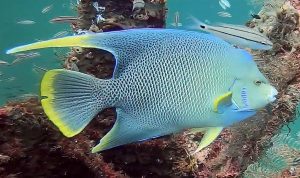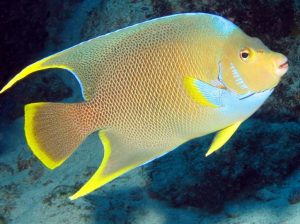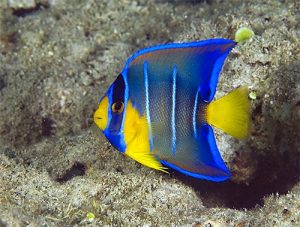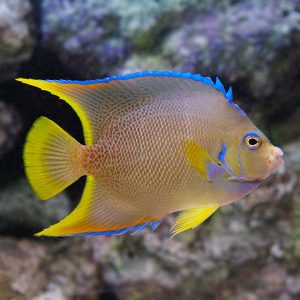The known to tropical fish keeping enthusiasts as the Bermuda Blue Angelfish is found in tropical western Atlantic waters along the coasts of North and South America from North Carolina to the Yucatan Peninsula; as well as Bermuda in the Bahamas.
Blue Angelfish are a benthic species that can be found near the bottom at depths from 5 to over 300 feet in areas with live rock, corals, and sponge growth. Adults are generally found singly or in pairs grazing on sponges, tunicates, corals, and algae. Juveniles are generally found in channels, bays, and along inshore reefs.
Similar to the Queen Angelfish, adult Blue Angelfish (Holacanthus bermudensis) have a yellow and blue brown shaded body with rirdescent blue accents and green hues, and bluish gray, yellow margined trailing dorsal and anal fins.
Queen Angelfish (Holacanthus ciliaris) posses a solid yellow tail, a striking blue crown, and deep blue highlights.
Juvenile Blue Angelfish have thin straight brilliant blue and white vertical bars on their dark blue bodies and bright yellow markings around the mouth, pectoral fins, and tail.
The bars on juvenile Blue Angelfish are straighter than the bars of juvenile Queen Angelfish. The colors gradually morph from the dark
blues of juveniles, to the blues, greens, and yellows of adult specimens.
Blue Angelfish and Queen Angelfish are hermaphroditic and have no distinguishing markings between males and females.
Where their ranges overlap, the Blue Angelfish will occasionally breed with the Queen Angelfish creating a hybrid called the Townsend Angelfish.
Because of it’s size, the Blue Angelfish (Holacanthus bermudensis) is best housed in at least a 250 gallon fish only tank with plenty of swimming areas and aged live rock to graze on; arranged into caves, overhangs, and crevices for them to hide among.
They are best kept with other semi aggressive species but because of their aggressiveness towards peaceful species and fish of similar and smaller size, they should never be kept with others of their own kind unless housed in an extremely large aquarium. Except for the most toxic corals from the Alcyoniidae or Octocoral family, Blue Angelfish are notorious nippers of stony and soft corals (sessile invertebrates) and clam mantles and are not considered to be reef safe. Crabs and shrimp are normally ignored.
Be sure to have adequate lighting to encourage algae growth on the rock work in your tank before introducing your fish. A daylight bulb is also recommended to help the angelfish absorb vitamins A and C.
Like most saltwater angelfish, the Blue Angelfish requires good quality water. Regular water changes of 10-15% every two weeks for tanks in the 180 gallon range and 30% every 3 to 4 weeks in tanks over 250 gallons are highly recommended to keep them stress free and healthy.
Because there are no distinguishing markings that differentiate males from females, Holacanthus bermudensis are extremely difficult to breed in an aquarium environment. To date there have been no successful breedings in an aquarium environment.
Holacanthus bermudensis spawn by slowly rising up in the water column, with their bellies close together, and releasing large amounts of eggs and sperm. Females can release anywhere from 25,000 to 75,000 transparent eggs each evening, and as many as ten million during each spawning period. Each pelagic egg contains a single drop of oil to provide buoyancy.
The eggs normally hatch in 15 to 20 hours into a pro-larval stage where after about 48 hours the yolk sac is absorbed the young are free swimming. The larvae are immediately able to feed on plankton, grow quickly, and in about 2 to 4 weeks settle to the bottom. Juveniles are strongly territorial and defend spots where they set up cleaning stations (like cleaner wrasses) where they eat parasites that they remove from other fish.
In the wild, adult Blue Angelfish eat mainly sponges and algae. In an aquarium environment with mature live rock for grazing, they will do well on a diet that includes sponge material in either frozen (Ocean Nutrition Formula One), freeze dried, flake, or pellet form in addition to vegetables like raw broccoli, marine algae, and meaty treats like fresh shrimp, brine, or Misys shrimp
.
Because they are grazers, it is recommended to feed several small meals throughout the day as opposed to one large meal.
Blue Angelfish (Holacanthus bermudensis) are available online from a variety of tropical fish keeping suppliers at the following approximate purches sizes; Medium: over 2.5-4.5″, Western Atlantic $159.99, Large: over 4.5-6.5″, Western Atlantic $169.99, X-Large: over 6.5-7.5″, Western Atlantic $229.99, XX-Large: over 7.5-8.5″, Western Atlantic $289.99 and Larger up to $400.00.
Minimum Tank Size: 250 gallons
Aquarium Type: Mature live rock or Reef
Care Level: Moderate
Temperament: Semi Aggressive
Aquarium Hardiness: Hardy
Water Conditions: 72 °F – 80 °F, dKH 8 to 12, pH 8.1 – 8.4, sg 1.023-1.025
Max. Size: 18″
Color Form: Black, Blue, Yellow
Diet: Omnivore
Compatibility: Not reef safe
Origin: North and South America, Caribbean
Family: Pomacanthidae
Lifespan: 20 years
Aquarist Experience Level: Expert






One Response to “Blue Angelfish (Holacanthus bermudensis)”
Trackbacks/Pingbacks
[…] to the Blue Angelfish (Holacanthus bermudensis) the Queen Angelfish (Holacanthus ciliaris) is covered in yellow tipped blue green scales, with a […]